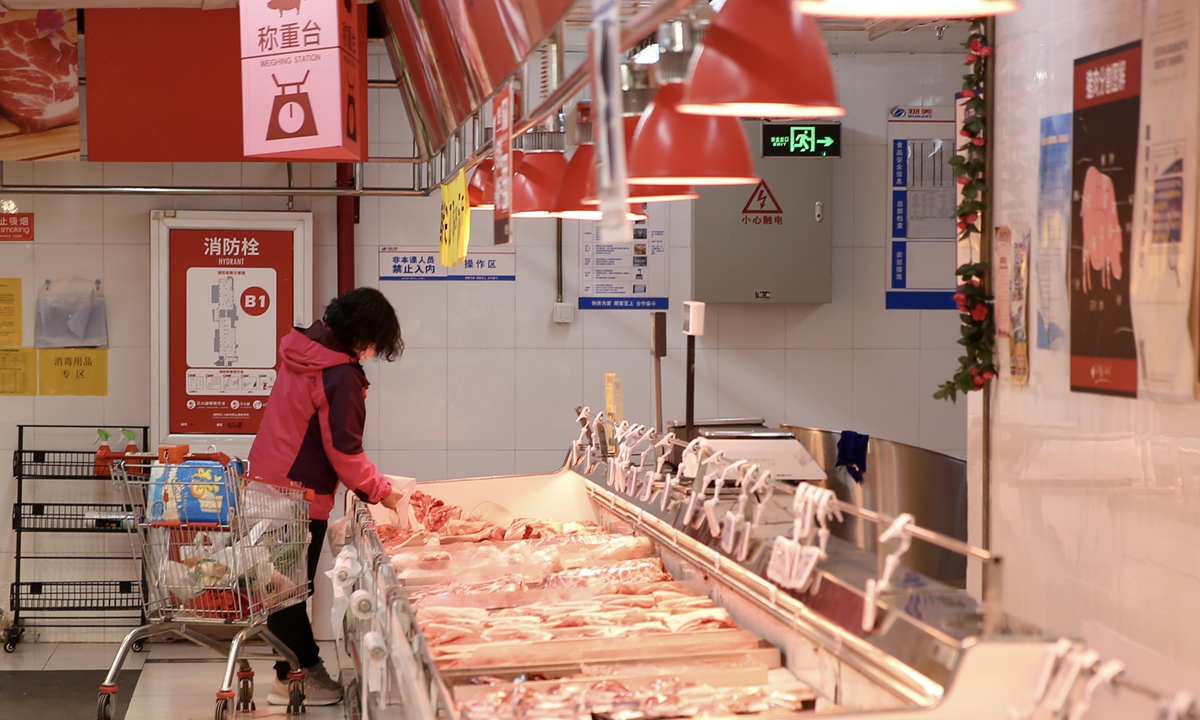
A woman browses through the fresh meat section at a supermarket in Beijing on Friday. The Ministry of Agriculture and Rural Affairs said pork prices in the second week of March have declined for seven consecutive weeks. Photo: cnsphoto
China's consumer price index (CPI), a main gauge of inflation, registered negative year-on-year growth in July for the first time in more than two years, which was expected by the market. Deemed as the possible lowest point over the year, analysts said that the index may change course and start to climb in the coming months.
The CPI edged down 0.3 percent on a yearly basis in July, while the factory-gate prices of bulk commodities saw a narrowed decline, data from the National Bureau of Statistics (NBS) showed on Wednesday.
The price of vegetables and pork, the two major categories that influence food prices, both fell in July, driving food prices down 1.7 percent on a yearly basis in July.
The price of pork tumbled by 26 percent year-on-year, the decline of which expanded by 18.8 percentage points compared with that of June, while prices of fresh vegetables dipped 1.5 percent compared with a 10.8 percent surge registered in June, NBS data showed.
Core CPI, deducting food and energy prices, rose 0.8 percent year-on-year, with the pace of increase widening by 0.4 percentage points compared with that in June.
Among the non-food items, prices across the tourism sector, which is currently running brisk because of summer holidays, rose 13.1 percent on a yearly basis in July, accelerating 6.7 percentage points compared with June's growth rate.
The country's CPI decline on a yearly basis was mainly due to a high base in the corresponding period of 2022, NBS statistician Dong Lijuan said in a statement.
"Overall, the CPI decline is a phased thing. In the next stage, with China's economic recovery picking up momentum and the market demand steadily expanding, coupled with the gradual erasing of last year's high base effect, the index will rise," Dong said.
If viewed on a monthly basis, China's consumer prices rose 0.2 percent in July compared with that of the previous month, underscoring the continued recovery of consumer demand.
Although the weak price data since the start of the second quarter has led to market concerns about a possible deflation, which could harm the economic recovery of the world's second largest economy, experts said there are no deflation risks for the full year as consumer prices are expected to rise in the third quarter with more policy stimulus being implemented.
Wang Qing, chief macroeconomic analyst at Golden Credit Rating International, told the Global Times on Wednesday that the negative growth of CPI is highly likely to be a "temporary phenomenon" against the backdrop of sustainable economic recovery and double-digit growth of M2 money supply.
M2, a broad measure of money supply that covers cash in circulation and all deposits, climbed 11.3 percent year-on-year to 287.3 trillion yuan ($39.9 trillion) at the end of June, according to the People's Bank of China.
Fu Linghui, a spokesperson for the NBS, said previously that there are multiple reasons for the weak CPI including complex and severe international environment, sluggish world economy, insufficient domestic demand and a relatively high base of the same period last year. He stressed the weakness is temporary.
Wu Chaoming, a deputy head of the Chasing Research Institute, told the Global Times on Wednesday that the CPI in July will likely be the lowest point of the year. The subsequent recovery of energy prices and the stabilization of pork prices will drive up the year-on-year growth of CPI to pick up.
However, Wu estimated that CPI growth could possibly remain in the negative territory in August and September, due to the high base in the third quarter of last year.
Wang forecast that the full-year CPI could return to the normal level of around 2 percent growth by the year end.
The average CPI from January to July increased by 0.5 percent year-on-year, according to the NBS data.
Along with the CPI, the NBS released July's producer price index (PPI), a main gauge of factory prices, which showed a year-on-year decline of 4.4 percent, posting a negative growth for 10 consecutive months. But the decline narrowed for the first time in seven months.
In June, the index hit its ebb since 2016 by dropping 5.4 percent year-on-year.
The narrowed decline of PPI is mainly due to sufficient domestic supply, demand improvement in some industrial lines, and shoring up of bulk commodity prices such as oil and coal, Dong said.




